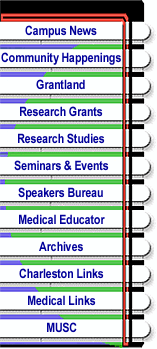
Return to Main Menu |
Pioneers
in sight restoration have ties to Charleston
Dr. David Apple wrote to the Post and Courier recently and shares his insight
with The Catalyst.
Letter to the editor:
Two events in the field of ophthalmology and eye surgery have recently
occurred that have had momentous impact on this specialty and also have
had close ties with the City of Charleston and the State of South Carolina.
We were saddened to learn in the June 3 issue of the Post and Courier
that Dr. Svyatoslav Fyodorov of Moscow had died in a helicopter crash in
that city. Dr. Fyodorov, a good friend of ours for many years, was one
of the inventors of radial keratotomy and modern corneal refractive surgery.
He gained international fame in the 1970s when a story of his “assembly
line” eye surgery in Moscow was aired on CBS's 60 Minutes. He personally
taught his surgical techniques to Dr. William Vallotton, my predecessor
at the Storm Eye Institute, who visited his clinic in Moscow. Dr. Vallotton
was the first to apply these surgical techniques in South Carolina.
His discoveries are now making a great impact. In Charleston. This
includes the development of the Magill Center of Vision Correction at the
Storm Eye Institute, which is providing excellent vision enhancement to
countless individuals in our state, especially with the laser (LASIK) technique.
This center was made possible by generous benefactors in Greenville, Holly
and Arthur Magill, who have also been tremendous benefactors to Spoleto.
The center is ably manned by Dr. Kerry Solomon, a former medical student
and researcher under my direction, who has grown into an outstanding specialist
in his field.
The second event is much happier. Dr. Harold Ridley, an ophthalmologist
in London, England, invented the intraocular lens, which is a plastic artificial
prostheses used after cataract surgery. He devised this after much research
on World War II fighter pilots with eye injuries who had fragments of plastic
in their eye from injuries in the Battle of Britain. His discovery and
first surgical implantation in 1949 has now led to the cure of cataracts,
which now affects three million people worldwide each year, and will affect
almost all of us before we pass away. I am sure there is almost no family
in the Lowcountry that does not have one or more relatives that have benefitted
from Mr. Ridley's invention.
Ridley was undiscovered and virtually ignored for almost 40 years,
until we invited him to Charleston and when Dr. James Edwards and our department
presented him with an honorary doctor's degree in 1989 (just before Hurricane
Hugo). His fame has subsequently spread. Dr. and Mrs. Ridley, also good
friends of the late Barbara Williams, a well-known Charleston philanthropist,
visited Charleston and the Storm Eye Institute several times in the 1990s.
Now 94 years of age, his acclaim has now reached a peak in that Knighthood
was conferred on him by Queen Elizabeth II on Feb. 9—a very unusual event
for an eye surgeon.
These two gentlemen have provided miraculous cures helping eradicate
blindness and poor vision to all of us in our state (and of course worldwide).
We are grateful for their accomplishments and we salute them.
Thank you very much.
Sincerely yours,
David J. Apple, M.D.
Pawek-Vallotton Chair of Biomedical Engineering
Professor of Ophthalmology and Pathology
Department of Ophthalmology, Storm Eye Institute
|


